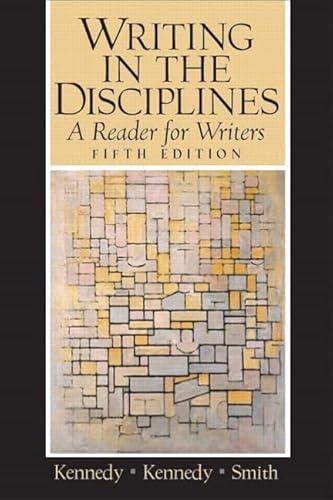Items related to Writing in the Disciplines: A Reader for Writers

Synopsis
This combination rhetoric/anthology shows readers how to read academic volumes effectively and how to use them as sources for papers in a variety of disciplines. Throughout, readers learn how to work individually and collaboratively as they move through the entire process of writing from sources?from reading the original source to planning, drafting and revising essays. The rhetoric section teaches readers the fundamental strategies for all phases of academic writing?critical reading, paraphrasing, summarizing, quoting, organizing, drafting, revising, editing, synthesizing, analyzing, researching, and developing arguments. The anthology section offers engaging reading selections that introduce readers to the issues and the methods of study in the sciences, social sciences, and humanities, and that serve as idea banks for their writing assignments. For individuals interested in a comprehensive treatment of academic writing.
"synopsis" may belong to another edition of this title.
From the Back Cover
This combination rhetoric/anthology shows readers how to read academic volumes effectively and how to use them as sources for papers in a variety of disciplines. Throughout, readers learn how to work individually and collaboratively as they move through the entire process of writing from sources—from reading the original source to planning, drafting and revising essays. The rhetoric section teaches readers the fundamental strategies for all phases of academic writing—critical reading, paraphrasing, summarizing, quoting, organizing, drafting, revising, editing, synthesizing, analyzing, researching, and developing arguments. The anthology section offers engaging reading selections that introduce readers to the issues and the methods of study in the sciences, social sciences, and humanities, and that serve as idea banks for their writing assignments. For individuals interested in a comprehensive treatment of academic writing.
"About this title" may belong to another edition of this title.
FREE shipping within U.S.A.
Destination, rates & speedsSearch results for Writing in the Disciplines: A Reader for Writers
Writing in the Disciplines: A Reader for Writers
Seller: Orion Tech, Kingwood, TX, U.S.A.
paperback. Condition: Good. Seller Inventory # 0131823825-3-33765271
Quantity: 1 available
Writing in the Disciplines A R
Seller: World of Books (was SecondSale), Montgomery, IL, U.S.A.
Condition: Good. Item in good condition. Textbooks may not include supplemental items i.e. CDs, access codes etc. Seller Inventory # 00082855480
Quantity: 3 available
Writing in the Disciplines A R
Seller: World of Books (was SecondSale), Montgomery, IL, U.S.A.
Condition: Acceptable. Item in acceptable condition! Textbooks may not include supplemental items i.e. CDs, access codes etc. Seller Inventory # 00085237888
Quantity: 1 available
Writing in the Disciplines A R
Seller: World of Books (was SecondSale), Montgomery, IL, U.S.A.
Condition: Very Good. Item in very good condition! Textbooks may not include supplemental items i.e. CDs, access codes etc. Seller Inventory # 00087684992
Quantity: 1 available
Writing in the Disciplines: A Reader for Writers
Seller: ThriftBooks-Dallas, Dallas, TX, U.S.A.
Paperback. Condition: Good. No Jacket. Pages can have notes/highlighting. Spine may show signs of wear. ~ ThriftBooks: Read More, Spend Less 1.88. Seller Inventory # G0131823825I3N00
Quantity: 1 available
Writing in the Disciplines: A Reader for Writers
Seller: ThriftBooks-Atlanta, AUSTELL, GA, U.S.A.
Paperback. Condition: Good. No Jacket. Pages can have notes/highlighting. Spine may show signs of wear. ~ ThriftBooks: Read More, Spend Less 1.88. Seller Inventory # G0131823825I3N00
Quantity: 1 available
Writing in the Disciplines: A Reader for Writers
Seller: ThriftBooks-Dallas, Dallas, TX, U.S.A.
Paperback. Condition: Fair. No Jacket. Readable copy. Pages may have considerable notes/highlighting. ~ ThriftBooks: Read More, Spend Less 1.88. Seller Inventory # G0131823825I5N00
Quantity: 1 available
Writing in the Disciplines: A Reader for Writers
Seller: ThriftBooks-Atlanta, AUSTELL, GA, U.S.A.
Paperback. Condition: Fair. No Jacket. Former library book; Readable copy. Pages may have considerable notes/highlighting. ~ ThriftBooks: Read More, Spend Less 1.88. Seller Inventory # G0131823825I5N10
Quantity: 1 available
Writing in the Disciplines: A Reader for Writers
Seller: New Legacy Books, Annandale, NJ, U.S.A.
paperback. Condition: Good. Fast shipping and order satisfaction guaranteed. A portion of your purchase benefits Non-Profit Organizations, First Aid and Fire Stations! Seller Inventory # 5FSZKH000FQV
Quantity: 1 available
Writing in the Disciplines: A Reader for Writers
Seller: HPB-Red, Dallas, TX, U.S.A.
paperback. Condition: Good. Connecting readers with great books since 1972! Used textbooks may not include companion materials such as access codes, etc. May have some wear or writing/highlighting. We ship orders daily and Customer Service is our top priority! Seller Inventory # S_441381666
Quantity: 1 available

